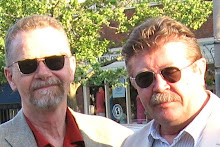THEATRE REVIEW: HARVEY
31 May'10
JOHN COULBOURN - QMI Agency
Rating: 3.5 out of 5
NIAGARA-ON-THE-LAKE — There is indeed more than one way to skin a cat — and apparently, more than one way to serve up a rabbit, invisible, or otherwise.
Director Joseph Ziegler proves that, more or less conclusively in the production of HARVEY he’s directed for the Shaw Festival this season. Harvey opened Saturday on the stage of the Shaw’s Royal George Theatre — and while it varies significantly from the 1950 film of the same name, it proves to be a certified crowd-pleaser nonetheless.
Written by Mary Chase, HARVEY could be described simply as the story of a man and his rabbit. Or, if one wants to delve more deeply into Chase’s tale, as the story of a man and his invisible rabbit — a pooka rabbit, to be specific, of Celtic legend, standing well over six feet tall in height and answering to the name of Harvey.
Over the course of several years, it seems, Harvey and his human friend, Elwood P. Dowd (played by Peter Krantz) have become quite familiar to most, if not all, of the citizens of the mid-western city in which the story is set. But while most of his friends and neighbours are apparently prepared to take a live-and-let-live view of the bonds between Elwood and his unconventional and unseen friend, it has become a cause of major concern to Elwood’s sister, Veta Louise (Mary Haney), and to her daughter, Myrtle May (Zarrin Darnell-Martin), who seems destined to wither on the marital vine, thanks to her uncle’s eccentric friendship. In desperation, Veta and her daughter decide the only way to deal with the embarrassing situation is to commit Elwood to the local mental home, where Elwood can be separated from his invisible furry friend. Of course, nothing goes as planned.
While Krantz, under Ziegler’s direction, cleaves pretty closely to a template established by Jimmy Stewart in the movie, Ziegler seems to encourage some of his other cast members to explore new directions.
Where Veta, for instance, has most often been played as a motherly, matronly sort, Haney gives her a touch of twisted and conniving Calvinism that, when coupled with an ability to steal scenes like a master criminal, proves to be utterly delightful. Darnell-Martin, however, never quite seems to find the centre of Myrtle May, an underwritten role that has most often been fleshed out by casting it in such a way as to suggest that spinsterhood is a clear and present danger, not merely a distant threat.
Ziegler has hits and misses with his supporting cast as well. Not surprisingly, veterans Norman Browning, Peter Millard, Guy Bannerman and Donna Belleville all turn in fine performances, the latter not only essaying the lovely and vague Mrs. Chumley, but stepping in to play the rather ditsy Mrs. Chauvenet for an injured and recovering Jennifer Phipps. But though Browning comes close to rivaling Haney as a scene stealer in his role as the venerable Dr. Chumley, head of Chumley’s Rest, his staff at the home can’t quite seem to figure things out.
As Dr. Sanderson and nurse Kelly respectively, Gray Powell and Diana Donnelly have not yet mastered the steps in the couple’s intricate relationship, while as orderly Wilson, a game Tim Ziegler seems completely at sea. But like Elwood himself, this production seems to generate enough good will that most people are prepared to overlook its eccentricities, particularly with a powerful assist from set designer Sue Lepage who transforms simple set changes into moments of wonder and delight.
And so Chase’s enduring endorsement of compassion and civility rings through loud and clear, a certain comfort to invisible pooka rabbits and their best friends everywhere.
Monday, May 31, 2010
Subscribe to:
Post Comments (Atom)




No comments:
Post a Comment